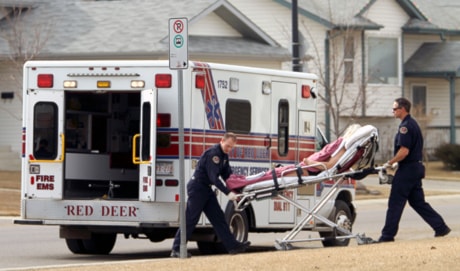The loss of four out of nine ambulances last year have not resulted in poor service for Red Deer residents, city council was told on Wednesday.
Emergency Services Manager Jack MacDonald said the City of Red Deer has avoided problems from removing four ambulances off city streets.
“It seems to be working just fine,” said MacDonald after presenting his department’s draft 2011 operational budget.
The city had been using nine ambulances for more than a year, but then moved to only five as of last August to meet contractual obligations with Alberta Health Services.
The reduction meant that after Red Deer’s five ambulances are used, an AHS ambulance from an outlying community responds.
The city works with partners in advance of the sixth call, so the ambulance from outside town is in Red Deer already.
“Sometimes it’s an ambulance from Lacombe being flexed in because we’re busy,” said MacDonald. “Sometimes it’s worked the other way where we’ve gone out to Lacombe when they’ve been short. It’s more regional than just municipal.”
Emergency Services also lessened the impact with continuing to have a fire engine respond to more serious incidents. The emergency personnel found on these pumpers also have Advanced Life Support training, which means at least one fire-medic on board must be a paramedic. They have more specialized skills than an emergency medical technician.
Emergency Services’s base budget for 2011 stands at $18.34 million and includes $26.5 million in expenses and another $8.16 million in revenue. Last year’s base budget was $17.8 million.
The budget includes no appeal for additional fire-medics.
Red Deer Emergency Services has 152 cross-trained fire-medics who provide fire suppression, rescue and hazardous materials response, as well as ALS emergency medical services.
Last year, the department added 30 fire-medics which helped achieve better response times to emergency calls. The first-arriving fire vehicle arrived at the scene within the target of four minutes or less, 84 per cent of the time in 2010 compared with 81 per cent. And for EMS, it set this benchmark 90 per cent of the time in 2010 as it did in 2009. The difference was that EMS had significantly more calls last year.
MacDonald said one challenge for 2011 centres on the uncertainty surrounding Red Deer’s contract with Alberta Health Services to provide ambulance services. It expires the end of March. The city has met with Alberta Health Services officials about extending Red Deer’s contract for another year or even longer, MacDonald said.
“The good news is we believe we’re going to stay in the business and we believe Alberta Health Services wants us to stay in the business,” said MacDonald.
Emergency Services continues to dispatch its own ambulances because a decision to move Red Deer’s EMS dispatch centre to Calgary was delayed to 2011, or possibly beyond. It is expecting revenue of nearly $601,000 in revenue from continuing to dispatch EMS in 2011.
Emergency Services is also proposing additional revenue through new fire dispatch contracts with Mountain View County ($45,000) and the Newell 911 Dispatch Association (just over $72,000).
ltester@www.reddeeradvocate.com
